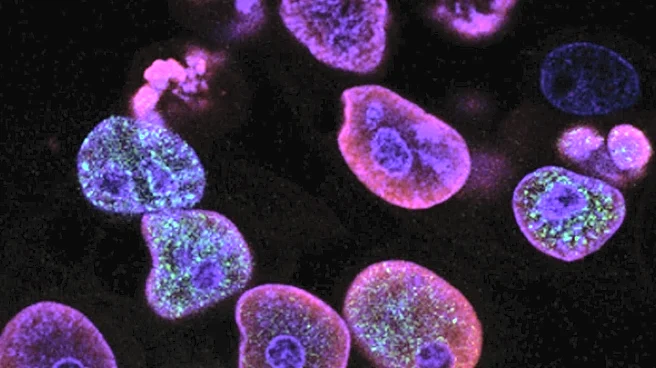What's Happening?
A recent study has explored the potential of phytochemicals derived from Camellia sinensis, commonly known as tea, in targeting the BRAF protein in melanoma treatment. Melanoma, a highly aggressive form of skin cancer, has seen a significant rise in incidence
globally. The study focuses on the BRAF V600E mutation, a common target in melanoma therapies. Researchers conducted molecular docking experiments with 248 compounds from Camellia sinensis, identifying three promising candidates: theaflagallin, epigallocatechin 3-O-cinnamate, and epicatechin gallate. These compounds demonstrated strong binding affinities and met drug-likeness criteria, suggesting their potential as therapeutic agents. The study highlights the need for natural anticancer drugs with fewer side effects compared to existing BRAF inhibitors like vemurafenib, which, while effective, can cause adverse effects such as drug resistance and cardiovascular issues.
Why It's Important?
The findings of this study are significant as they propose a natural alternative to current melanoma treatments, which often come with severe side effects and resistance issues. The use of phytochemicals from Camellia sinensis could lead to the development of safer, multi-target anticancer therapies. This approach not only addresses the limitations of existing BRAF inhibitors but also aligns with the growing demand for natural and less toxic cancer treatments. The potential for these compounds to offer a broader spectrum of action against various BRAF mutations could enhance treatment efficacy and personalization, benefiting patients with different genetic profiles of melanoma.
What's Next?
Future research is expected to focus on further validating the pharmacological properties of the identified compounds through in vitro and in vivo studies. This includes testing their efficacy and safety in melanoma models and exploring their potential in combination therapies to overcome resistance mechanisms. The study suggests that combining theaflagallin with MEK inhibitors could counteract MAPK pathway reactivation, a common resistance pathway in melanoma treatment. These steps are crucial for advancing these compounds from the laboratory to clinical trials, potentially leading to new, effective melanoma therapies.
Beyond the Headlines
The study underscores the importance of exploring natural compounds in drug development, particularly for diseases like melanoma where treatment options are limited by side effects and resistance. The use of computational methods to identify promising drug candidates highlights the role of technology in accelerating drug discovery. Additionally, the research opens avenues for personalized medicine approaches, as understanding the interaction of these compounds with various BRAF mutations could lead to tailored treatments for melanoma patients.














